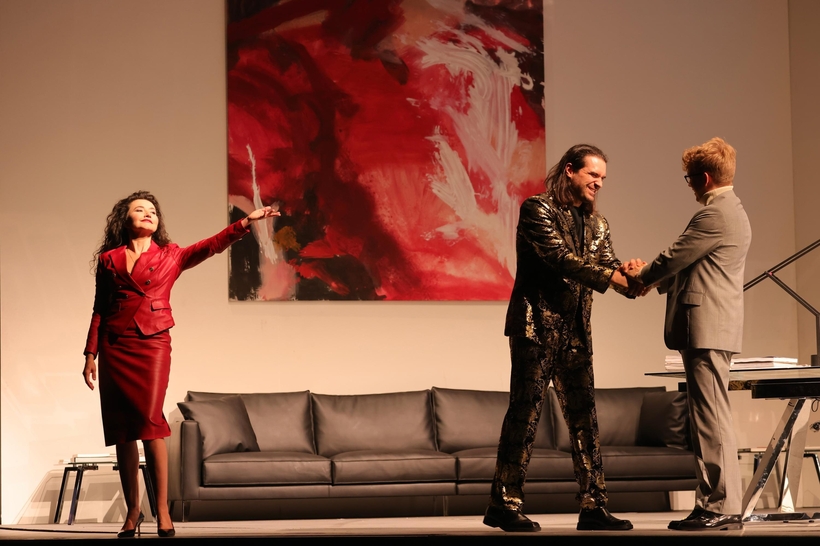In a crunch, which is stronger? Love or philosophical detachment?
Antonio Cesti’s L’Orontea, named for an Egyptian queen who just wants to do her job, opens in time-honored Baroque fashion with an allegorical prologue that poses just this question. The answer comes with the midsummer madness of the main action, involving a sage who urges the monarch to marry for her subjects’ sake, a hot artist on the run from a foreign princess, a frisky old lady who goes full nympho for a cool cross-dressing dude who’s not a dude, and a drunken baritone buffoon whose voice keeps cracking into falsetto.
A new production of the opera—directed by the pictorially fastidious, psychologically astute Robert Carsen, conducted by Giovanni Antonini—is currently on the boards at Milan’s illustrious Teatro alla Scala. Stéphanie d’Oustrac takes the volatile title role. The October 4 performance streams live and on demand through October 12.

Except for the absence of a historical subject, the storytelling in L’Orontea (1656) bears a striking resemblance to that of the aged Monteverdi’s genre-defying (read: “Shakespearean”) masterpiece L’Incoronazione di Poppea (1643). Musically, too, Cesti is speaking the same language. And why not? It’s made to order for casts of characters perpetually in a tizzy. Talking on pitch, or “recitative,” predominates, unpredictably punctuated by melodic shivers of emotion and delicious bursts of outright song. The instrumental tapestry is shot through with dulcet woodwinds, twanging strings (bowed or plucked) that sting and sigh by turns, deft percussion, and imperious brass. But at this early stage of the Baroque period, don’t expect much by way of detachable, formally structured arias à la Vivaldi and Handel, who didn’t come along until a half century later.
Scores of this description presuppose more intimate stages than La Scala’s, which was not inaugurated until 1778. But like all ambitious lyric theaters today, Milan’s flagship company strives for the encyclopedic. And so, the Italians of the 1600s have started coming into their own here as well. In October 2021, La Scala took a first step with Francesco Cavalli’s La Calisto (Venice, 1651).

A canny choice: in recent decades, Cavalli’s scintillant mythological sex farce has deservedly been enjoying quite a vogue. The La Scala production fielded the top-drawer Baroque specialist Christophe Rousset on the podium and choice talent in leading parts, including Chen Reiss as the nymph Calisto and Christophe Dumaux as the dreamy Endymion. But David McVicar’s uncharacteristically anarchic, head-banging production proved unlovely in itself and out of sync with the material. I couldn’t watch. Check it out for yourself, if you care to, on the company’s streaming platform LaScalaTv.
Likewise available is Leonardo Vinci’s far rarer Neapolitan curio Li Zite ’ngalera (The Newlyweds Go to Sea), a knockabout upstairs-downstairs sitcom of Handelian vintage, but not a bit like Handel. The conductor Andrea Marcon, another top gun of Baroque revivals, leads a dynamite cast of new faces who are also native speakers of the zesty Naples dialect. In Leo Muscato’s lovingly traditional staging, that credential matters more than you might think. As the girl juggling three suitors (or is it four?), Francesca Pia Vitale takes your breath away. Watch for her as the courtesan Silandra in L’Orontea.
La Calisto and Li Zite ’ngalera are available for streaming on the LaScalaTv Web Site. L’Orontea will stream live on October 4 at 7:45 P.M. C.E.T. and remain on the LaScalaTv Web Site through October 12
Matthew Gurewitsch writes about opera and classical music for AIR MAIL. He lives in Hawaii

